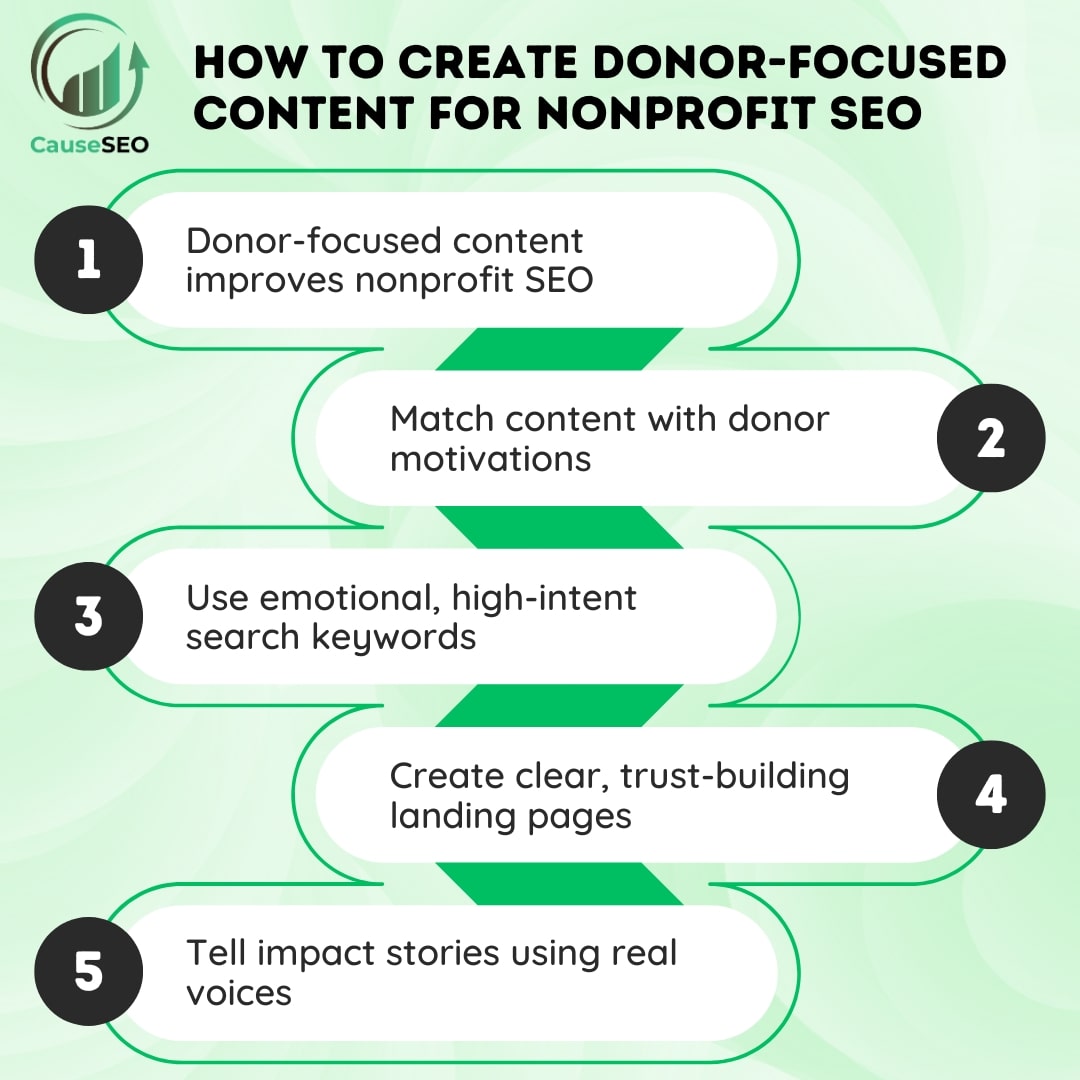Have you ever wondered why some nonprofit websites seem to connect so well with donors—while others struggle to get noticed or trusted? The answer often comes down to how they approach content. Content for Nonprofit SEO is not just about inserting keywords or ranking on Google. It’s about creating material that speaks directly to the people who care enough to give.
Too many charities focus their messaging inward—highlighting programs, staff, or achievements—without considering what the donor actually wants to see. When you flip that perspective and make your content donor-centered, not only does it resonate more, but it also performs better in search.
In this guide, we will walk through how to write content that helps donors find you, trust you, and feel good about giving. You’ll learn how to shape your pages, choose keywords that matter, and write in a way that builds both emotional connection and search visibility.

Understanding Donor Intent in SEO
What Are Donors Really Searching For?
Most donors are not Googling your nonprofit’s name. They’re searching for ways to help. Phrases like “how to support displaced families” or “trusted charities for clean water” reflect a need to make a difference, not just get informed.
That means their search intent is emotional and trust-based. They want to feel confident that their donation will have an impact and that the organization is reliable.
Aligning Content with Donor Motivations
Different donors care about different things. Some give monthly because they want sustained impact. Others give during crises. Legacy donors may be driven by values and long-term vision.
Match your messaging accordingly. For monthly donors, highlight ongoing impact. For crisis donors, focus on urgency and transparent needs. Use language that reflects what they care about—results, trust, and human stories.
Core Pages Every Donor-Focused Website Needs
Donation Landing Page
This is where action happens. Use a strong emotional headline, a clear and simple call to action, and trust signals like security badges, testimonials, or third-party ratings.
Make sure the URL is clean and includes keywords (e.g., /donate-to-clean-water). Write meta tags that are compelling and search-friendly.
Impact Stories or Case Studies
Show real results. Highlight individuals, families, or communities who have benefited from donations. Add direct quotes or visuals where possible.
Optimize these pages for SEO with phrases like “how donations changed lives” or “impact of donating to [your cause].” These stories connect emotionally and support organic search growth.
About + Financial Transparency Pages
Transparency builds confidence. Share how you use donations with plain language. Break down the information with headers and short sections.
Adding FAQs like “How much of my donation goes to the cause?” helps with both SEO and user experience. This is where donors go when they’re on the fence.
Keyword Strategy for Donor-Centered Content
Focus on High-Intent Keywords
Donors search with action in mind. Use tools like Ahrefs, Ubersuggest, or Google Trends to find keywords like:
- “best charities for disaster relief”
- “monthly donation for child education”
- “trusted clean water charities”
These show intent to give, not just learn.
Long-Tail + Emotional Keywords
Go beyond generic phrases. Think like your audience. A donor might search “help families in Gaza” instead of “Gaza nonprofit.”
These emotional, specific phrases may have lower volume but stronger conversion potential.
Map Keywords to Funnel Stages
Your content should cover all stages of donor intent:
- Awareness: “why donate to rainforest protection”
- Consideration: “nonprofits helping Amazon tribes”
- Conversion: “donate to save the Amazon rainforest”
This approach builds a path from discovery to donation.

How to Structure Content That Builds Trust and Converts
Use the “You” Voice and Storytelling
Talk to your audience. Use the word “you” more than “we.” Instead of saying, “We run clean water programs,” try, “Your donation helps bring clean water to families.”
Include real voices—quotes from donors or people you’ve helped. These stories are powerful and persuasive.
Combine SEO Elements with Donor Persuasion
Use emotional headlines that still include target keywords. Write meta descriptions that invite clicks, like:
“Looking for trusted ways to help? See how your gift changes lives with our clean water program.”
Include internal links to your donation pages and use schema markup for FAQs or donation events to improve visibility.
Content Types That Attract and Retain Donors
Blog Posts That Educate and Inspire
Write posts that help donors understand their impact:
- “What your $20 can do for a child’s future”
- “What happens after you donate to our refugee fund”
These posts are highly shareable and help with link building—two key factors in SEO for nonprofits.
Email and Landing Page SEO Alignment
Turn your blog content into email campaigns. Use consistent keywords in both places. This strengthens your messaging and helps Google connect the dots between your content and user behavior.
Mistakes to Avoid When Writing for Donors
Writing for Internal Stakeholders, Not the Donor
It’s easy to write from your nonprofit’s perspective. But your content should be about the reader, not your resume. Cut jargon. Simplify stats. Show impact.
Over-Optimizing and Losing Emotional Impact
SEO is important, but keyword stuffing is not. Don’t let optimization overshadow clarity and emotion. Use keywords naturally, not mechanically.

Frequently Asked Questions
Q1: How do I know what content donors want to read?
Use Google Trends, review competitor blogs, and ask donors directly. Analytics tools also reveal what content drives donations.
Q2: Can content help improve donations or just SEO?
Both. Donor-focused SEO content leads to more traffic, better trust, and higher conversions.
Q3: How often should a nonprofit update its content?
At least once every quarter. Keep donation pages current and blog content aligned with seasonal or urgent topics.
Q4: What’s better—blog posts or landing pages for donations?
Landing pages are best for direct conversions. Blog posts support discovery and trust. Use both together.
Q5: How do I combine storytelling with keyword targeting?
Start with the story. Then refine headlines and subheads using relevant keywords. Don’t force it—keep the voice natural.
Q6: Can donor-focused content help with local SEO too?
Yes. Add location-based terms (e.g., “food bank in Winnipeg”) and optimize your Google Business Profile.
Conclusion
Donor-focused content is not just good storytelling—it’s smart strategy. By aligning content with donor intent and using thoughtful SEO practices, your nonprofit can reach more people and increase support.
CauseSEO helps charities do just that. In fact, we helped Trees for the Future increase donation page visits by 315% through optimized content built around donor intent.
Ready to grow your impact?

